Early Childhood Education: Nurturing Children's Creativity
VerifiedAdded on 2020/06/06
|25
|8885
|115
Homework Assignment
AI Summary
This assignment focuses on fostering creativity in children through various activities and assessments suitable for early childhood education. It covers a range of topics, including using natural materials for art, incorporating music and dance, promoting a sense of responsibility for materials, and encouraging improvisation. The assignment includes formative and summative assessments to evaluate children's understanding and engagement. It also explores ways to stimulate dramatic and imaginative play, and provides techniques for teaching children about different art forms. The document emphasizes the importance of educators allowing children to express their original ideas and providing a supportive environment for creative exploration. It provides practical examples of how to encourage children's participation and development in different creative areas, offering insights into the value of music, movement, and dramatic play in nurturing their creative potential. The document concludes with references to support the information provided.
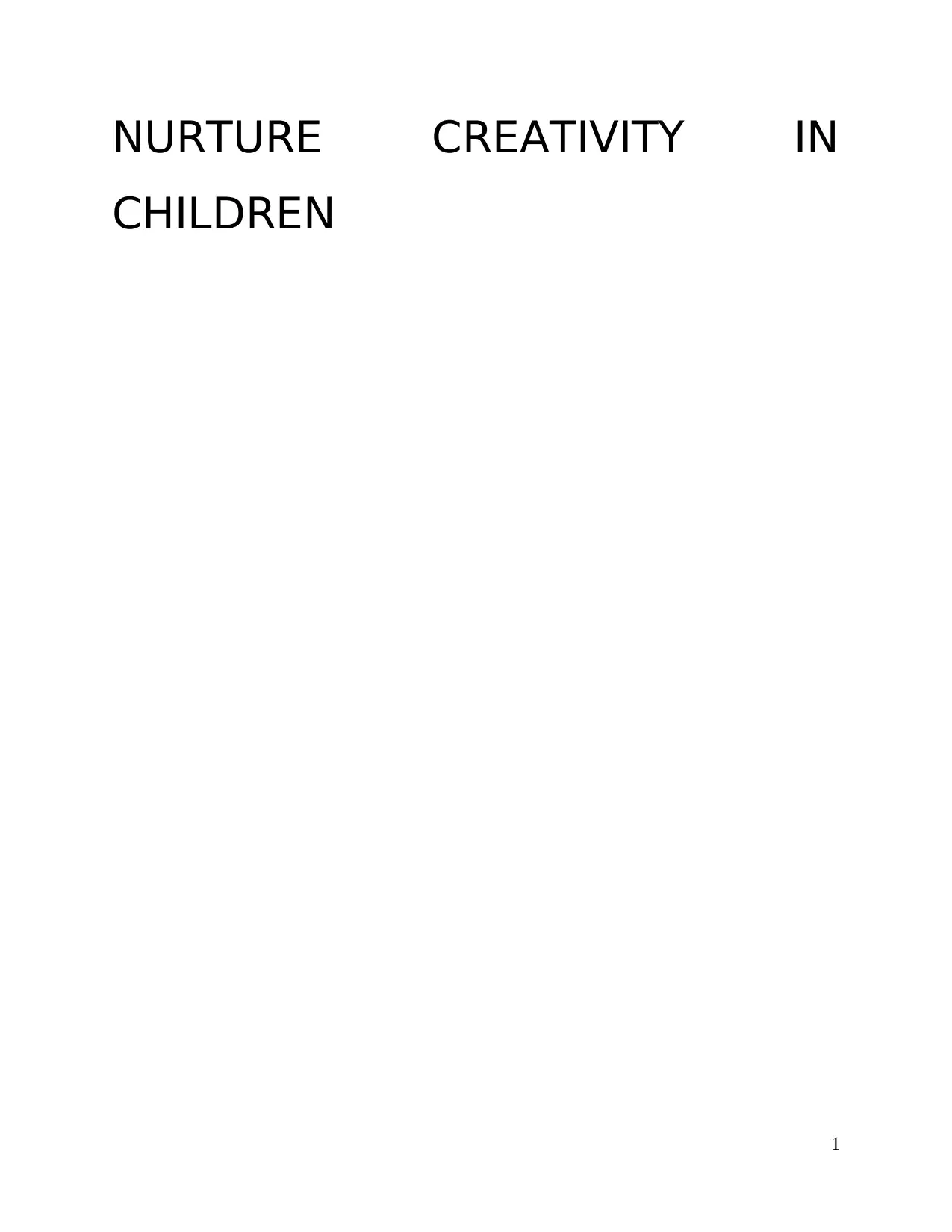
NURTURE CREATIVITY IN
CHILDREN
1
CHILDREN
1
Paraphrase This Document
Need a fresh take? Get an instant paraphrase of this document with our AI Paraphraser
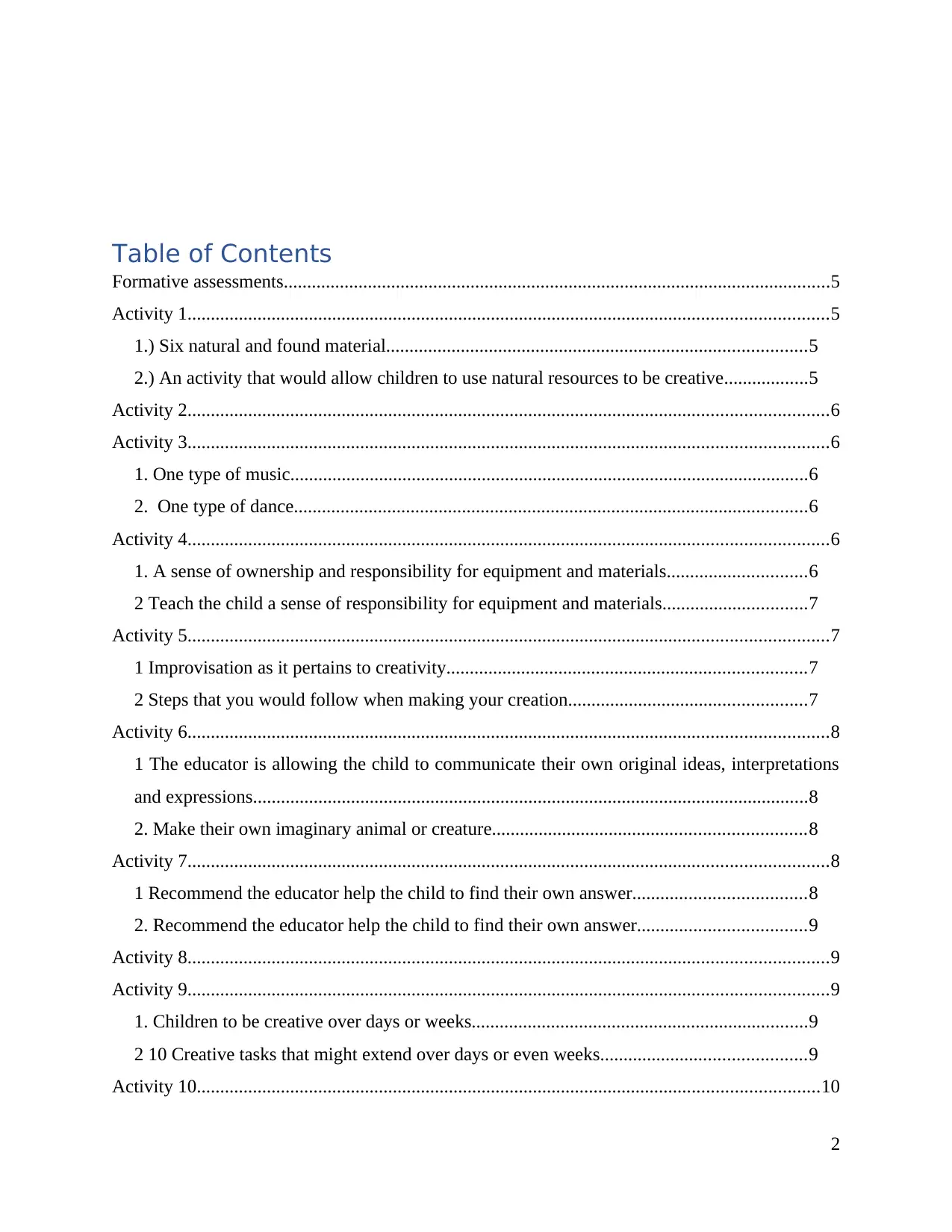
Table of Contents
Formative assessments.....................................................................................................................5
Activity 1.........................................................................................................................................5
1.) Six natural and found material..........................................................................................5
2.) An activity that would allow children to use natural resources to be creative..................5
Activity 2.........................................................................................................................................6
Activity 3.........................................................................................................................................6
1. One type of music...............................................................................................................6
2. One type of dance..............................................................................................................6
Activity 4.........................................................................................................................................6
1. A sense of ownership and responsibility for equipment and materials..............................6
2 Teach the child a sense of responsibility for equipment and materials...............................7
Activity 5.........................................................................................................................................7
1 Improvisation as it pertains to creativity.............................................................................7
2 Steps that you would follow when making your creation...................................................7
Activity 6.........................................................................................................................................8
1 The educator is allowing the child to communicate their own original ideas, interpretations
and expressions.......................................................................................................................8
2. Make their own imaginary animal or creature...................................................................8
Activity 7.........................................................................................................................................8
1 Recommend the educator help the child to find their own answer.....................................8
2. Recommend the educator help the child to find their own answer....................................9
Activity 8.........................................................................................................................................9
Activity 9.........................................................................................................................................9
1. Children to be creative over days or weeks........................................................................9
2 10 Creative tasks that might extend over days or even weeks............................................9
Activity 10.....................................................................................................................................10
2
Formative assessments.....................................................................................................................5
Activity 1.........................................................................................................................................5
1.) Six natural and found material..........................................................................................5
2.) An activity that would allow children to use natural resources to be creative..................5
Activity 2.........................................................................................................................................6
Activity 3.........................................................................................................................................6
1. One type of music...............................................................................................................6
2. One type of dance..............................................................................................................6
Activity 4.........................................................................................................................................6
1. A sense of ownership and responsibility for equipment and materials..............................6
2 Teach the child a sense of responsibility for equipment and materials...............................7
Activity 5.........................................................................................................................................7
1 Improvisation as it pertains to creativity.............................................................................7
2 Steps that you would follow when making your creation...................................................7
Activity 6.........................................................................................................................................8
1 The educator is allowing the child to communicate their own original ideas, interpretations
and expressions.......................................................................................................................8
2. Make their own imaginary animal or creature...................................................................8
Activity 7.........................................................................................................................................8
1 Recommend the educator help the child to find their own answer.....................................8
2. Recommend the educator help the child to find their own answer....................................9
Activity 8.........................................................................................................................................9
Activity 9.........................................................................................................................................9
1. Children to be creative over days or weeks........................................................................9
2 10 Creative tasks that might extend over days or even weeks............................................9
Activity 10.....................................................................................................................................10
2
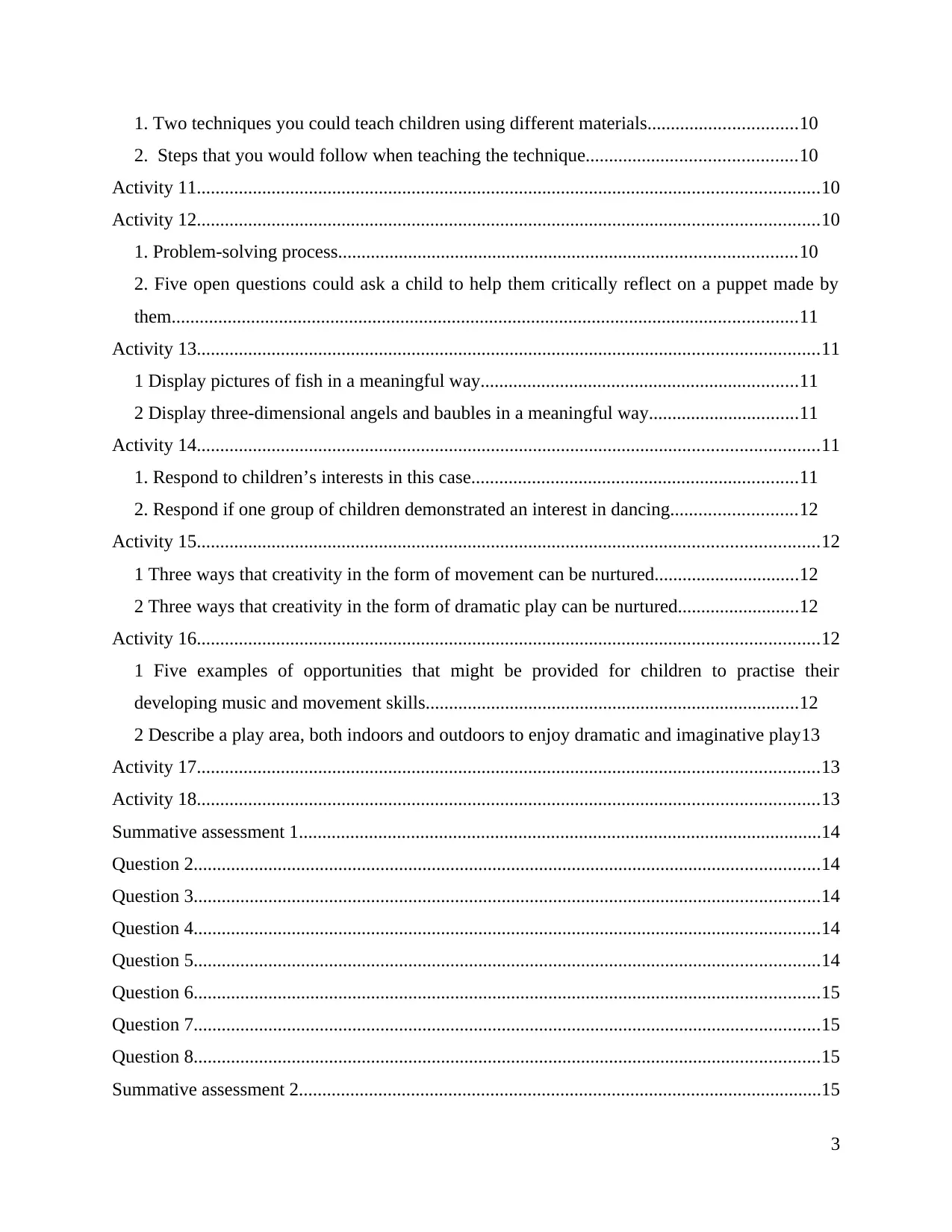
1. Two techniques you could teach children using different materials................................10
2. Steps that you would follow when teaching the technique.............................................10
Activity 11.....................................................................................................................................10
Activity 12.....................................................................................................................................10
1. Problem-solving process..................................................................................................10
2. Five open questions could ask a child to help them critically reflect on a puppet made by
them......................................................................................................................................11
Activity 13.....................................................................................................................................11
1 Display pictures of fish in a meaningful way....................................................................11
2 Display three-dimensional angels and baubles in a meaningful way................................11
Activity 14.....................................................................................................................................11
1. Respond to children’s interests in this case......................................................................11
2. Respond if one group of children demonstrated an interest in dancing...........................12
Activity 15.....................................................................................................................................12
1 Three ways that creativity in the form of movement can be nurtured...............................12
2 Three ways that creativity in the form of dramatic play can be nurtured..........................12
Activity 16.....................................................................................................................................12
1 Five examples of opportunities that might be provided for children to practise their
developing music and movement skills................................................................................12
2 Describe a play area, both indoors and outdoors to enjoy dramatic and imaginative play13
Activity 17.....................................................................................................................................13
Activity 18.....................................................................................................................................13
Summative assessment 1................................................................................................................14
Question 2......................................................................................................................................14
Question 3......................................................................................................................................14
Question 4......................................................................................................................................14
Question 5......................................................................................................................................14
Question 6......................................................................................................................................15
Question 7......................................................................................................................................15
Question 8......................................................................................................................................15
Summative assessment 2................................................................................................................15
3
2. Steps that you would follow when teaching the technique.............................................10
Activity 11.....................................................................................................................................10
Activity 12.....................................................................................................................................10
1. Problem-solving process..................................................................................................10
2. Five open questions could ask a child to help them critically reflect on a puppet made by
them......................................................................................................................................11
Activity 13.....................................................................................................................................11
1 Display pictures of fish in a meaningful way....................................................................11
2 Display three-dimensional angels and baubles in a meaningful way................................11
Activity 14.....................................................................................................................................11
1. Respond to children’s interests in this case......................................................................11
2. Respond if one group of children demonstrated an interest in dancing...........................12
Activity 15.....................................................................................................................................12
1 Three ways that creativity in the form of movement can be nurtured...............................12
2 Three ways that creativity in the form of dramatic play can be nurtured..........................12
Activity 16.....................................................................................................................................12
1 Five examples of opportunities that might be provided for children to practise their
developing music and movement skills................................................................................12
2 Describe a play area, both indoors and outdoors to enjoy dramatic and imaginative play13
Activity 17.....................................................................................................................................13
Activity 18.....................................................................................................................................13
Summative assessment 1................................................................................................................14
Question 2......................................................................................................................................14
Question 3......................................................................................................................................14
Question 4......................................................................................................................................14
Question 5......................................................................................................................................14
Question 6......................................................................................................................................15
Question 7......................................................................................................................................15
Question 8......................................................................................................................................15
Summative assessment 2................................................................................................................15
3
⊘ This is a preview!⊘
Do you want full access?
Subscribe today to unlock all pages.

Trusted by 1+ million students worldwide
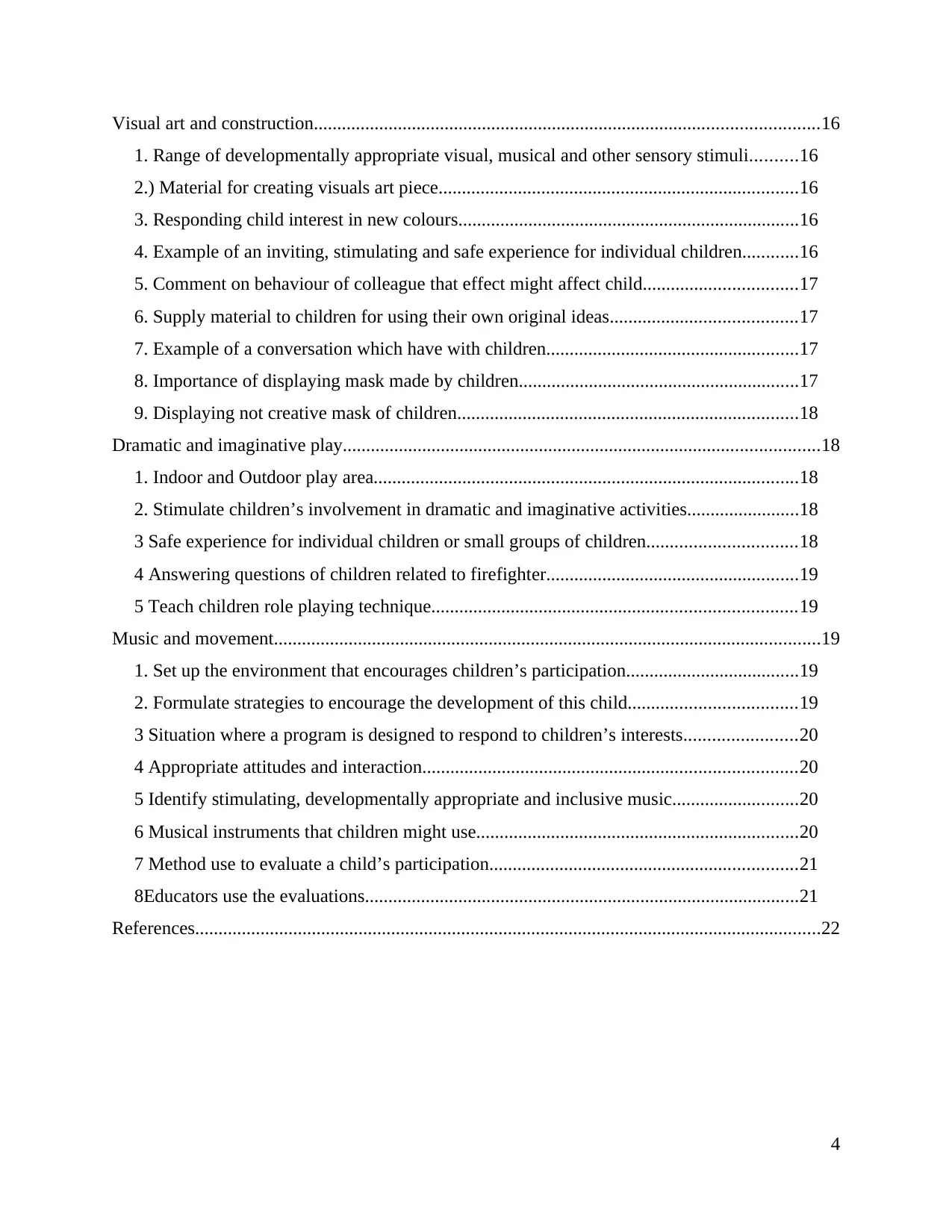
Visual art and construction............................................................................................................16
1. Range of developmentally appropriate visual, musical and other sensory stimuli..........16
2.) Material for creating visuals art piece.............................................................................16
3. Responding child interest in new colours.........................................................................16
4. Example of an inviting, stimulating and safe experience for individual children............16
5. Comment on behaviour of colleague that effect might affect child.................................17
6. Supply material to children for using their own original ideas........................................17
7. Example of a conversation which have with children......................................................17
8. Importance of displaying mask made by children............................................................17
9. Displaying not creative mask of children.........................................................................18
Dramatic and imaginative play......................................................................................................18
1. Indoor and Outdoor play area...........................................................................................18
2. Stimulate children’s involvement in dramatic and imaginative activities........................18
3 Safe experience for individual children or small groups of children................................18
4 Answering questions of children related to firefighter......................................................19
5 Teach children role playing technique..............................................................................19
Music and movement.....................................................................................................................19
1. Set up the environment that encourages children’s participation.....................................19
2. Formulate strategies to encourage the development of this child....................................19
3 Situation where a program is designed to respond to children’s interests........................20
4 Appropriate attitudes and interaction................................................................................20
5 Identify stimulating, developmentally appropriate and inclusive music...........................20
6 Musical instruments that children might use.....................................................................20
7 Method use to evaluate a child’s participation..................................................................21
8Educators use the evaluations.............................................................................................21
References......................................................................................................................................22
4
1. Range of developmentally appropriate visual, musical and other sensory stimuli..........16
2.) Material for creating visuals art piece.............................................................................16
3. Responding child interest in new colours.........................................................................16
4. Example of an inviting, stimulating and safe experience for individual children............16
5. Comment on behaviour of colleague that effect might affect child.................................17
6. Supply material to children for using their own original ideas........................................17
7. Example of a conversation which have with children......................................................17
8. Importance of displaying mask made by children............................................................17
9. Displaying not creative mask of children.........................................................................18
Dramatic and imaginative play......................................................................................................18
1. Indoor and Outdoor play area...........................................................................................18
2. Stimulate children’s involvement in dramatic and imaginative activities........................18
3 Safe experience for individual children or small groups of children................................18
4 Answering questions of children related to firefighter......................................................19
5 Teach children role playing technique..............................................................................19
Music and movement.....................................................................................................................19
1. Set up the environment that encourages children’s participation.....................................19
2. Formulate strategies to encourage the development of this child....................................19
3 Situation where a program is designed to respond to children’s interests........................20
4 Appropriate attitudes and interaction................................................................................20
5 Identify stimulating, developmentally appropriate and inclusive music...........................20
6 Musical instruments that children might use.....................................................................20
7 Method use to evaluate a child’s participation..................................................................21
8Educators use the evaluations.............................................................................................21
References......................................................................................................................................22
4
Paraphrase This Document
Need a fresh take? Get an instant paraphrase of this document with our AI Paraphraser
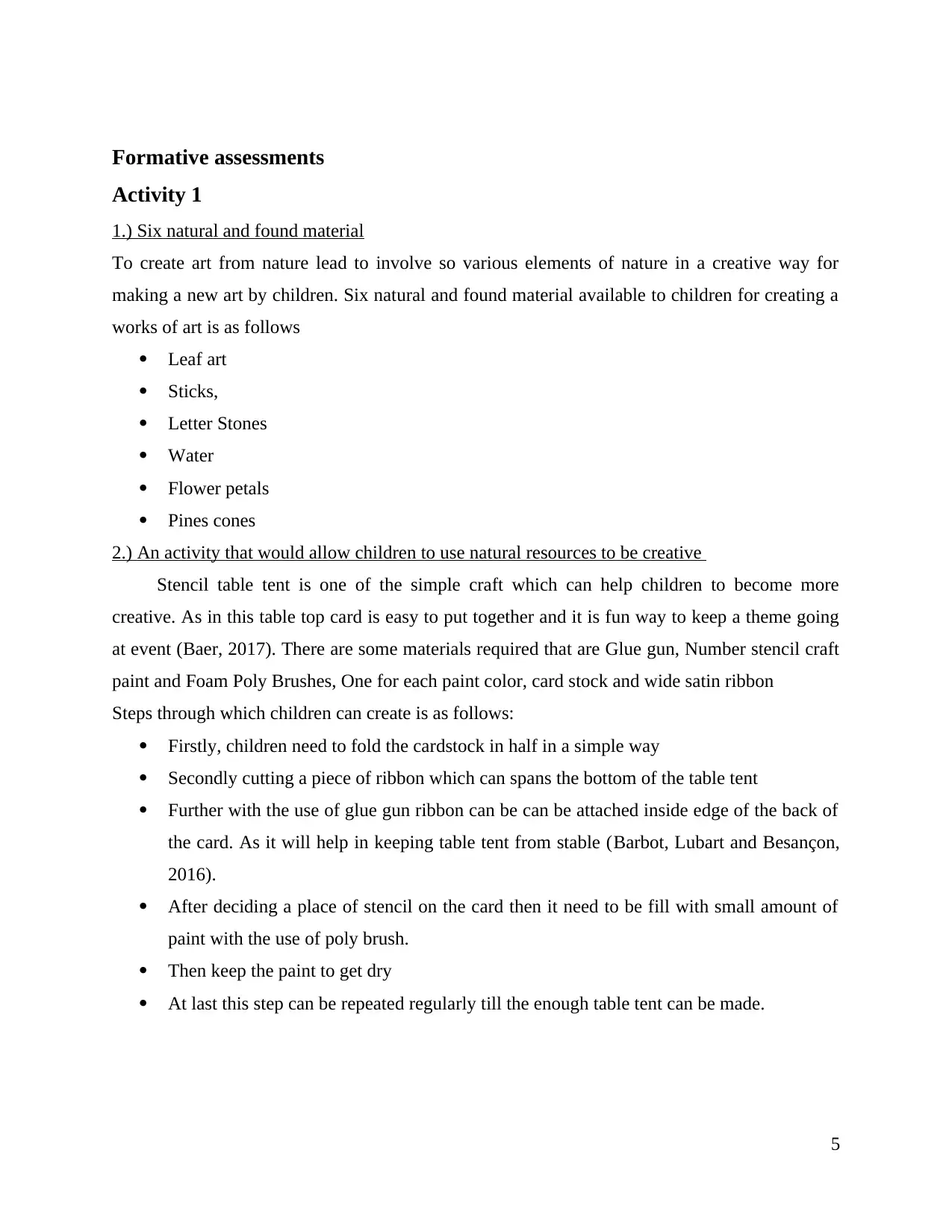
Formative assessments
Activity 1
1.) Six natural and found material
To create art from nature lead to involve so various elements of nature in a creative way for
making a new art by children. Six natural and found material available to children for creating a
works of art is as follows
Leaf art
Sticks,
Letter Stones
Water
Flower petals
Pines cones
2.) An activity that would allow children to use natural resources to be creative
Stencil table tent is one of the simple craft which can help children to become more
creative. As in this table top card is easy to put together and it is fun way to keep a theme going
at event (Baer, 2017). There are some materials required that are Glue gun, Number stencil craft
paint and Foam Poly Brushes, One for each paint color, card stock and wide satin ribbon
Steps through which children can create is as follows:
Firstly, children need to fold the cardstock in half in a simple way
Secondly cutting a piece of ribbon which can spans the bottom of the table tent
Further with the use of glue gun ribbon can be can be attached inside edge of the back of
the card. As it will help in keeping table tent from stable (Barbot, Lubart and Besançon,
2016).
After deciding a place of stencil on the card then it need to be fill with small amount of
paint with the use of poly brush.
Then keep the paint to get dry
At last this step can be repeated regularly till the enough table tent can be made.
5
Activity 1
1.) Six natural and found material
To create art from nature lead to involve so various elements of nature in a creative way for
making a new art by children. Six natural and found material available to children for creating a
works of art is as follows
Leaf art
Sticks,
Letter Stones
Water
Flower petals
Pines cones
2.) An activity that would allow children to use natural resources to be creative
Stencil table tent is one of the simple craft which can help children to become more
creative. As in this table top card is easy to put together and it is fun way to keep a theme going
at event (Baer, 2017). There are some materials required that are Glue gun, Number stencil craft
paint and Foam Poly Brushes, One for each paint color, card stock and wide satin ribbon
Steps through which children can create is as follows:
Firstly, children need to fold the cardstock in half in a simple way
Secondly cutting a piece of ribbon which can spans the bottom of the table tent
Further with the use of glue gun ribbon can be can be attached inside edge of the back of
the card. As it will help in keeping table tent from stable (Barbot, Lubart and Besançon,
2016).
After deciding a place of stencil on the card then it need to be fill with small amount of
paint with the use of poly brush.
Then keep the paint to get dry
At last this step can be repeated regularly till the enough table tent can be made.
5
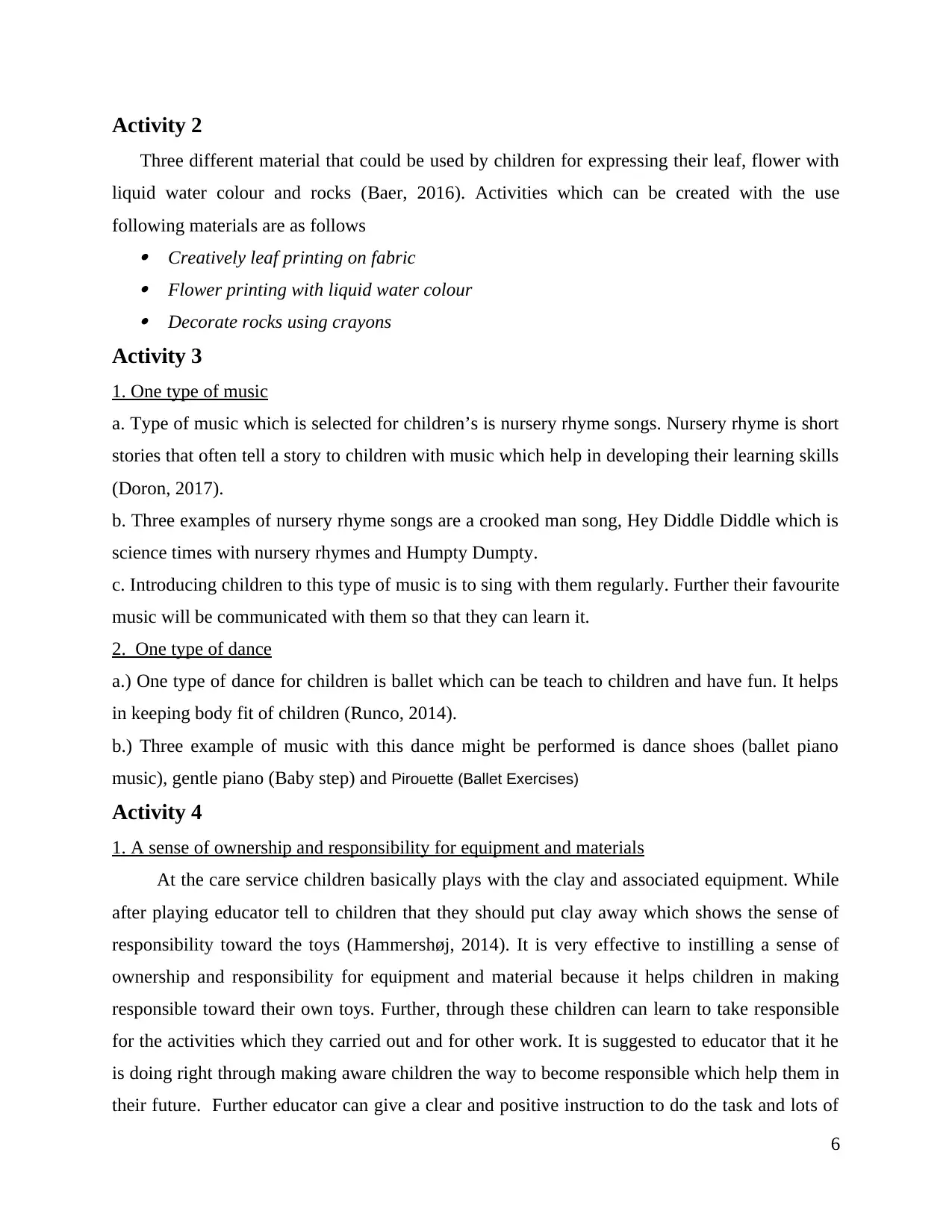
Activity 2
Three different material that could be used by children for expressing their leaf, flower with
liquid water colour and rocks (Baer, 2016). Activities which can be created with the use
following materials are as follows Creatively leaf printing on fabric Flower printing with liquid water colour Decorate rocks using crayons
Activity 3
1. One type of music
a. Type of music which is selected for children’s is nursery rhyme songs. Nursery rhyme is short
stories that often tell a story to children with music which help in developing their learning skills
(Doron, 2017).
b. Three examples of nursery rhyme songs are a crooked man song, Hey Diddle Diddle which is
science times with nursery rhymes and Humpty Dumpty.
c. Introducing children to this type of music is to sing with them regularly. Further their favourite
music will be communicated with them so that they can learn it.
2. One type of dance
a.) One type of dance for children is ballet which can be teach to children and have fun. It helps
in keeping body fit of children (Runco, 2014).
b.) Three example of music with this dance might be performed is dance shoes (ballet piano
music), gentle piano (Baby step) and Pirouette (Ballet Exercises)
Activity 4
1. A sense of ownership and responsibility for equipment and materials
At the care service children basically plays with the clay and associated equipment. While
after playing educator tell to children that they should put clay away which shows the sense of
responsibility toward the toys (Hammershøj, 2014). It is very effective to instilling a sense of
ownership and responsibility for equipment and material because it helps children in making
responsible toward their own toys. Further, through these children can learn to take responsible
for the activities which they carried out and for other work. It is suggested to educator that it he
is doing right through making aware children the way to become responsible which help them in
their future. Further educator can give a clear and positive instruction to do the task and lots of
6
Three different material that could be used by children for expressing their leaf, flower with
liquid water colour and rocks (Baer, 2016). Activities which can be created with the use
following materials are as follows Creatively leaf printing on fabric Flower printing with liquid water colour Decorate rocks using crayons
Activity 3
1. One type of music
a. Type of music which is selected for children’s is nursery rhyme songs. Nursery rhyme is short
stories that often tell a story to children with music which help in developing their learning skills
(Doron, 2017).
b. Three examples of nursery rhyme songs are a crooked man song, Hey Diddle Diddle which is
science times with nursery rhymes and Humpty Dumpty.
c. Introducing children to this type of music is to sing with them regularly. Further their favourite
music will be communicated with them so that they can learn it.
2. One type of dance
a.) One type of dance for children is ballet which can be teach to children and have fun. It helps
in keeping body fit of children (Runco, 2014).
b.) Three example of music with this dance might be performed is dance shoes (ballet piano
music), gentle piano (Baby step) and Pirouette (Ballet Exercises)
Activity 4
1. A sense of ownership and responsibility for equipment and materials
At the care service children basically plays with the clay and associated equipment. While
after playing educator tell to children that they should put clay away which shows the sense of
responsibility toward the toys (Hammershøj, 2014). It is very effective to instilling a sense of
ownership and responsibility for equipment and material because it helps children in making
responsible toward their own toys. Further, through these children can learn to take responsible
for the activities which they carried out and for other work. It is suggested to educator that it he
is doing right through making aware children the way to become responsible which help them in
their future. Further educator can give a clear and positive instruction to do the task and lots of
6
⊘ This is a preview!⊘
Do you want full access?
Subscribe today to unlock all pages.

Trusted by 1+ million students worldwide
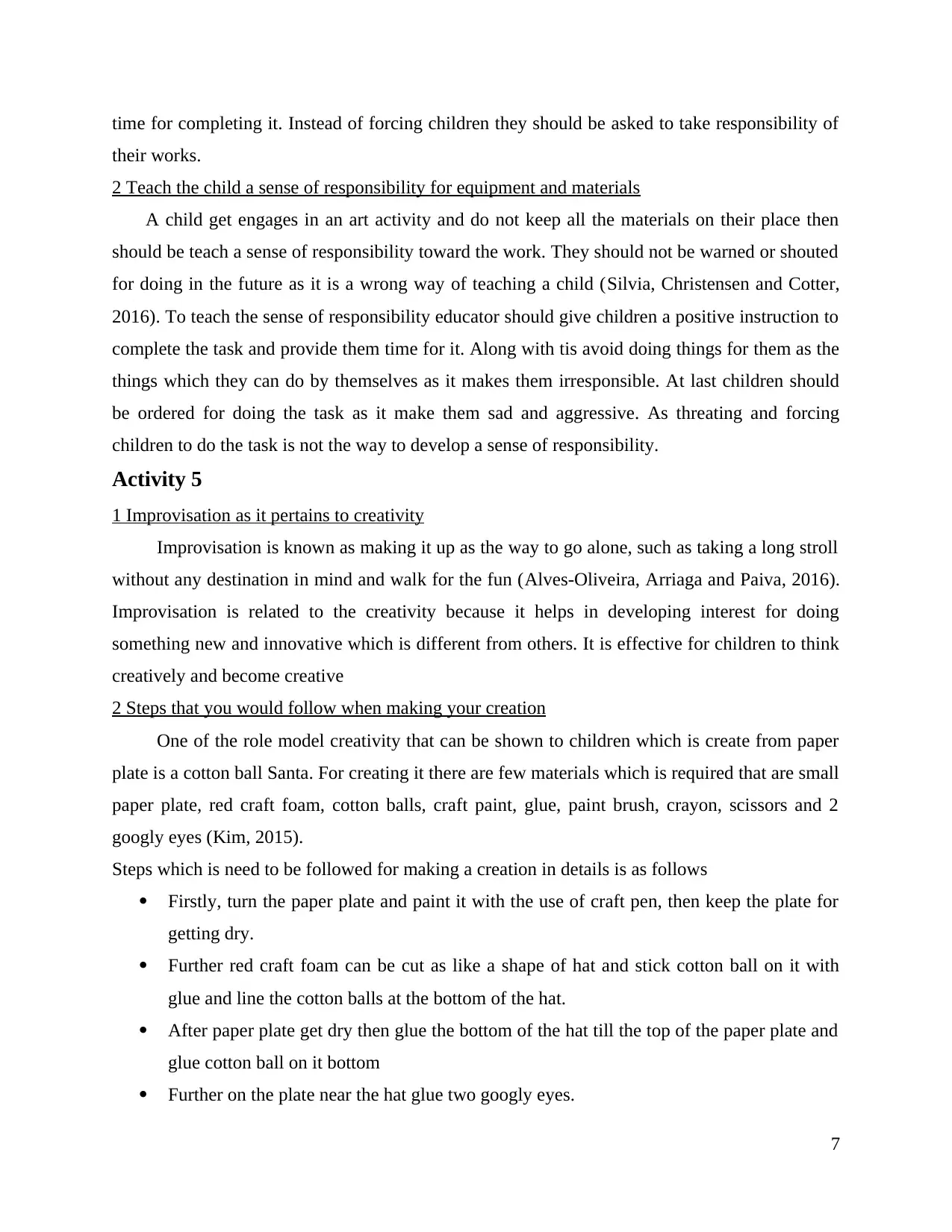
time for completing it. Instead of forcing children they should be asked to take responsibility of
their works.
2 Teach the child a sense of responsibility for equipment and materials
A child get engages in an art activity and do not keep all the materials on their place then
should be teach a sense of responsibility toward the work. They should not be warned or shouted
for doing in the future as it is a wrong way of teaching a child (Silvia, Christensen and Cotter,
2016). To teach the sense of responsibility educator should give children a positive instruction to
complete the task and provide them time for it. Along with tis avoid doing things for them as the
things which they can do by themselves as it makes them irresponsible. At last children should
be ordered for doing the task as it make them sad and aggressive. As threating and forcing
children to do the task is not the way to develop a sense of responsibility.
Activity 5
1 Improvisation as it pertains to creativity
Improvisation is known as making it up as the way to go alone, such as taking a long stroll
without any destination in mind and walk for the fun (Alves-Oliveira, Arriaga and Paiva, 2016).
Improvisation is related to the creativity because it helps in developing interest for doing
something new and innovative which is different from others. It is effective for children to think
creatively and become creative
2 Steps that you would follow when making your creation
One of the role model creativity that can be shown to children which is create from paper
plate is a cotton ball Santa. For creating it there are few materials which is required that are small
paper plate, red craft foam, cotton balls, craft paint, glue, paint brush, crayon, scissors and 2
googly eyes (Kim, 2015).
Steps which is need to be followed for making a creation in details is as follows
Firstly, turn the paper plate and paint it with the use of craft pen, then keep the plate for
getting dry.
Further red craft foam can be cut as like a shape of hat and stick cotton ball on it with
glue and line the cotton balls at the bottom of the hat.
After paper plate get dry then glue the bottom of the hat till the top of the paper plate and
glue cotton ball on it bottom
Further on the plate near the hat glue two googly eyes.
7
their works.
2 Teach the child a sense of responsibility for equipment and materials
A child get engages in an art activity and do not keep all the materials on their place then
should be teach a sense of responsibility toward the work. They should not be warned or shouted
for doing in the future as it is a wrong way of teaching a child (Silvia, Christensen and Cotter,
2016). To teach the sense of responsibility educator should give children a positive instruction to
complete the task and provide them time for it. Along with tis avoid doing things for them as the
things which they can do by themselves as it makes them irresponsible. At last children should
be ordered for doing the task as it make them sad and aggressive. As threating and forcing
children to do the task is not the way to develop a sense of responsibility.
Activity 5
1 Improvisation as it pertains to creativity
Improvisation is known as making it up as the way to go alone, such as taking a long stroll
without any destination in mind and walk for the fun (Alves-Oliveira, Arriaga and Paiva, 2016).
Improvisation is related to the creativity because it helps in developing interest for doing
something new and innovative which is different from others. It is effective for children to think
creatively and become creative
2 Steps that you would follow when making your creation
One of the role model creativity that can be shown to children which is create from paper
plate is a cotton ball Santa. For creating it there are few materials which is required that are small
paper plate, red craft foam, cotton balls, craft paint, glue, paint brush, crayon, scissors and 2
googly eyes (Kim, 2015).
Steps which is need to be followed for making a creation in details is as follows
Firstly, turn the paper plate and paint it with the use of craft pen, then keep the plate for
getting dry.
Further red craft foam can be cut as like a shape of hat and stick cotton ball on it with
glue and line the cotton balls at the bottom of the hat.
After paper plate get dry then glue the bottom of the hat till the top of the paper plate and
glue cotton ball on it bottom
Further on the plate near the hat glue two googly eyes.
7
Paraphrase This Document
Need a fresh take? Get an instant paraphrase of this document with our AI Paraphraser
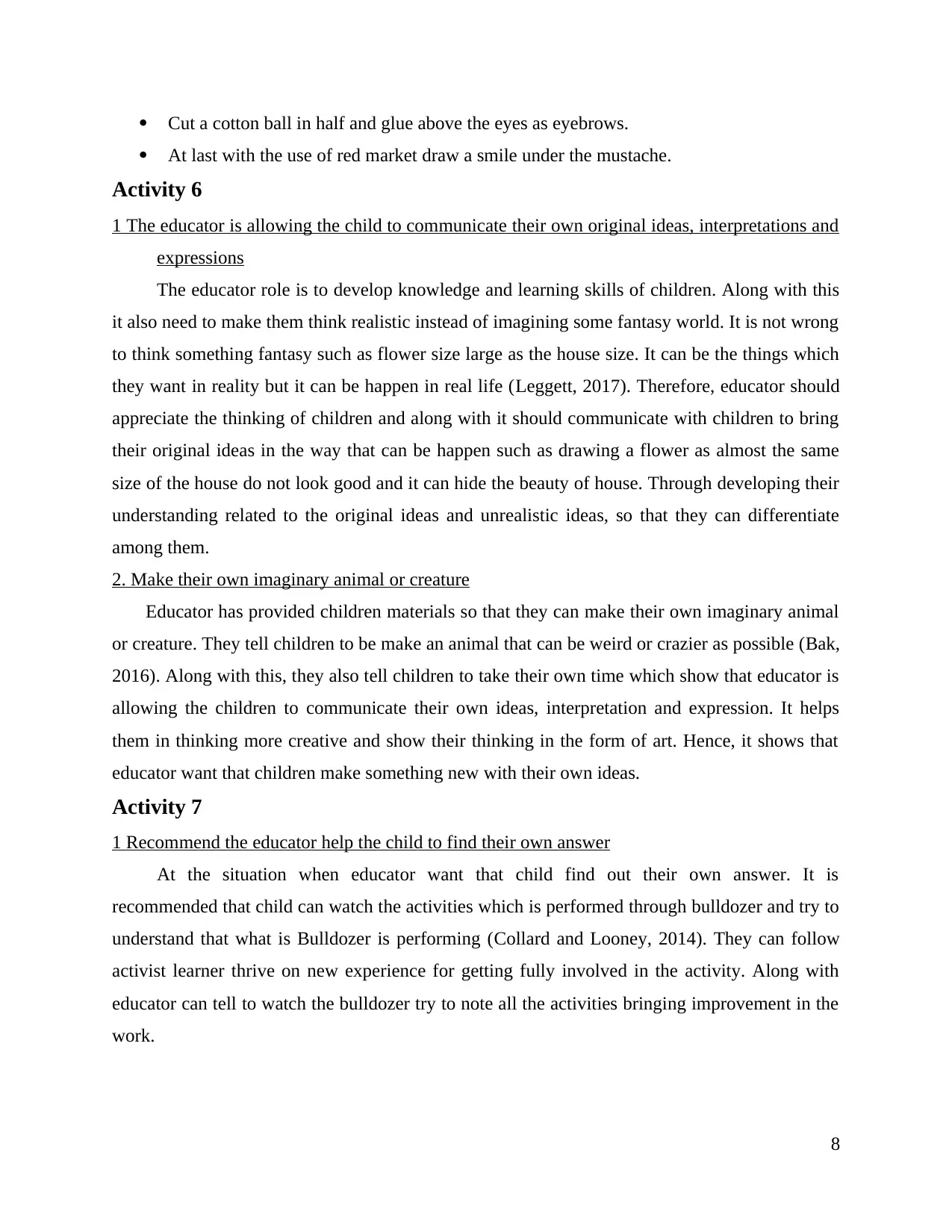
Cut a cotton ball in half and glue above the eyes as eyebrows.
At last with the use of red market draw a smile under the mustache.
Activity 6
1 The educator is allowing the child to communicate their own original ideas, interpretations and
expressions
The educator role is to develop knowledge and learning skills of children. Along with this
it also need to make them think realistic instead of imagining some fantasy world. It is not wrong
to think something fantasy such as flower size large as the house size. It can be the things which
they want in reality but it can be happen in real life (Leggett, 2017). Therefore, educator should
appreciate the thinking of children and along with it should communicate with children to bring
their original ideas in the way that can be happen such as drawing a flower as almost the same
size of the house do not look good and it can hide the beauty of house. Through developing their
understanding related to the original ideas and unrealistic ideas, so that they can differentiate
among them.
2. Make their own imaginary animal or creature
Educator has provided children materials so that they can make their own imaginary animal
or creature. They tell children to be make an animal that can be weird or crazier as possible (Bak,
2016). Along with this, they also tell children to take their own time which show that educator is
allowing the children to communicate their own ideas, interpretation and expression. It helps
them in thinking more creative and show their thinking in the form of art. Hence, it shows that
educator want that children make something new with their own ideas.
Activity 7
1 Recommend the educator help the child to find their own answer
At the situation when educator want that child find out their own answer. It is
recommended that child can watch the activities which is performed through bulldozer and try to
understand that what is Bulldozer is performing (Collard and Looney, 2014). They can follow
activist learner thrive on new experience for getting fully involved in the activity. Along with
educator can tell to watch the bulldozer try to note all the activities bringing improvement in the
work.
8
At last with the use of red market draw a smile under the mustache.
Activity 6
1 The educator is allowing the child to communicate their own original ideas, interpretations and
expressions
The educator role is to develop knowledge and learning skills of children. Along with this
it also need to make them think realistic instead of imagining some fantasy world. It is not wrong
to think something fantasy such as flower size large as the house size. It can be the things which
they want in reality but it can be happen in real life (Leggett, 2017). Therefore, educator should
appreciate the thinking of children and along with it should communicate with children to bring
their original ideas in the way that can be happen such as drawing a flower as almost the same
size of the house do not look good and it can hide the beauty of house. Through developing their
understanding related to the original ideas and unrealistic ideas, so that they can differentiate
among them.
2. Make their own imaginary animal or creature
Educator has provided children materials so that they can make their own imaginary animal
or creature. They tell children to be make an animal that can be weird or crazier as possible (Bak,
2016). Along with this, they also tell children to take their own time which show that educator is
allowing the children to communicate their own ideas, interpretation and expression. It helps
them in thinking more creative and show their thinking in the form of art. Hence, it shows that
educator want that children make something new with their own ideas.
Activity 7
1 Recommend the educator help the child to find their own answer
At the situation when educator want that child find out their own answer. It is
recommended that child can watch the activities which is performed through bulldozer and try to
understand that what is Bulldozer is performing (Collard and Looney, 2014). They can follow
activist learner thrive on new experience for getting fully involved in the activity. Along with
educator can tell to watch the bulldozer try to note all the activities bringing improvement in the
work.
8
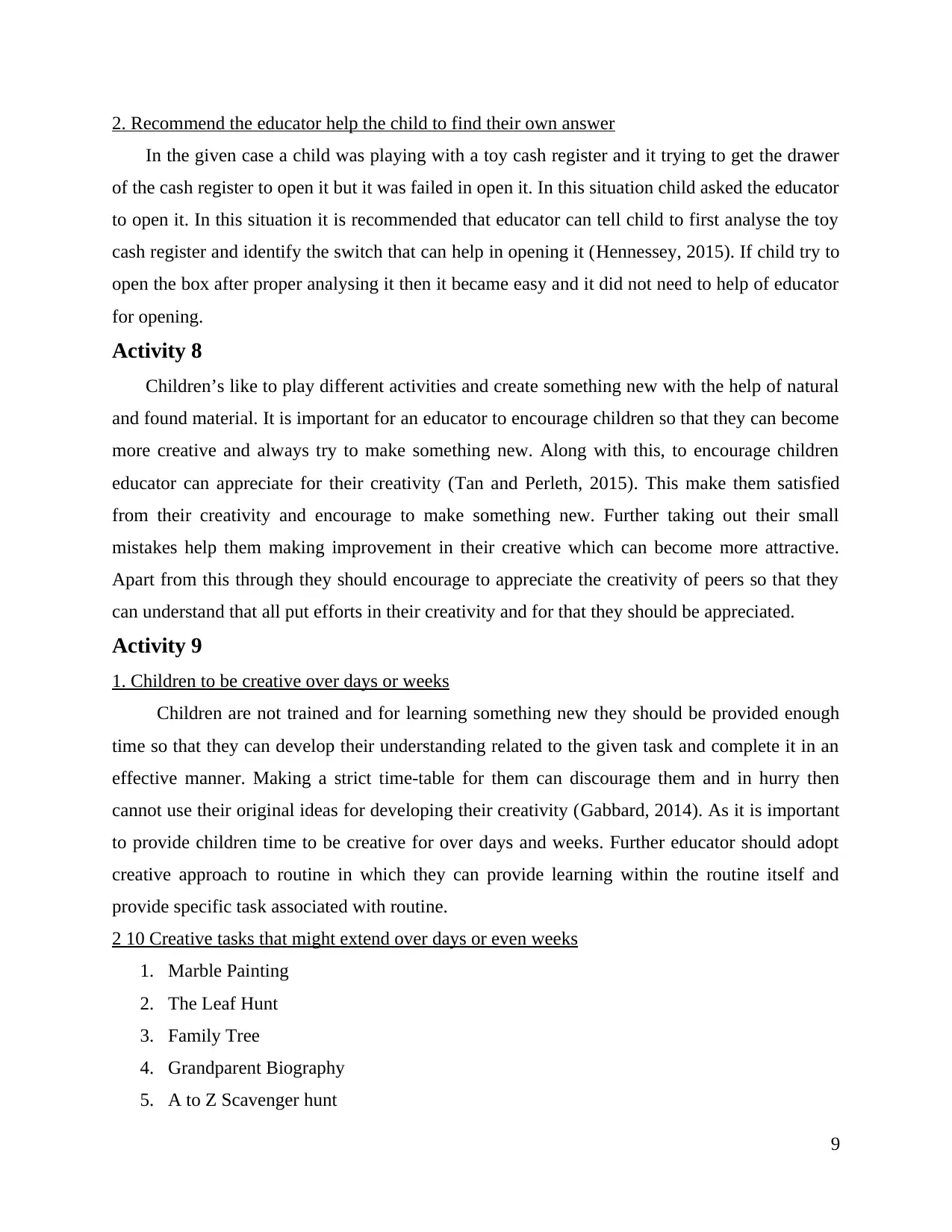
2. Recommend the educator help the child to find their own answer
In the given case a child was playing with a toy cash register and it trying to get the drawer
of the cash register to open it but it was failed in open it. In this situation child asked the educator
to open it. In this situation it is recommended that educator can tell child to first analyse the toy
cash register and identify the switch that can help in opening it (Hennessey, 2015). If child try to
open the box after proper analysing it then it became easy and it did not need to help of educator
for opening.
Activity 8
Children’s like to play different activities and create something new with the help of natural
and found material. It is important for an educator to encourage children so that they can become
more creative and always try to make something new. Along with this, to encourage children
educator can appreciate for their creativity (Tan and Perleth, 2015). This make them satisfied
from their creativity and encourage to make something new. Further taking out their small
mistakes help them making improvement in their creative which can become more attractive.
Apart from this through they should encourage to appreciate the creativity of peers so that they
can understand that all put efforts in their creativity and for that they should be appreciated.
Activity 9
1. Children to be creative over days or weeks
Children are not trained and for learning something new they should be provided enough
time so that they can develop their understanding related to the given task and complete it in an
effective manner. Making a strict time-table for them can discourage them and in hurry then
cannot use their original ideas for developing their creativity (Gabbard, 2014). As it is important
to provide children time to be creative for over days and weeks. Further educator should adopt
creative approach to routine in which they can provide learning within the routine itself and
provide specific task associated with routine.
2 10 Creative tasks that might extend over days or even weeks
1. Marble Painting
2. The Leaf Hunt
3. Family Tree
4. Grandparent Biography
5. A to Z Scavenger hunt
9
In the given case a child was playing with a toy cash register and it trying to get the drawer
of the cash register to open it but it was failed in open it. In this situation child asked the educator
to open it. In this situation it is recommended that educator can tell child to first analyse the toy
cash register and identify the switch that can help in opening it (Hennessey, 2015). If child try to
open the box after proper analysing it then it became easy and it did not need to help of educator
for opening.
Activity 8
Children’s like to play different activities and create something new with the help of natural
and found material. It is important for an educator to encourage children so that they can become
more creative and always try to make something new. Along with this, to encourage children
educator can appreciate for their creativity (Tan and Perleth, 2015). This make them satisfied
from their creativity and encourage to make something new. Further taking out their small
mistakes help them making improvement in their creative which can become more attractive.
Apart from this through they should encourage to appreciate the creativity of peers so that they
can understand that all put efforts in their creativity and for that they should be appreciated.
Activity 9
1. Children to be creative over days or weeks
Children are not trained and for learning something new they should be provided enough
time so that they can develop their understanding related to the given task and complete it in an
effective manner. Making a strict time-table for them can discourage them and in hurry then
cannot use their original ideas for developing their creativity (Gabbard, 2014). As it is important
to provide children time to be creative for over days and weeks. Further educator should adopt
creative approach to routine in which they can provide learning within the routine itself and
provide specific task associated with routine.
2 10 Creative tasks that might extend over days or even weeks
1. Marble Painting
2. The Leaf Hunt
3. Family Tree
4. Grandparent Biography
5. A to Z Scavenger hunt
9
⊘ This is a preview!⊘
Do you want full access?
Subscribe today to unlock all pages.

Trusted by 1+ million students worldwide
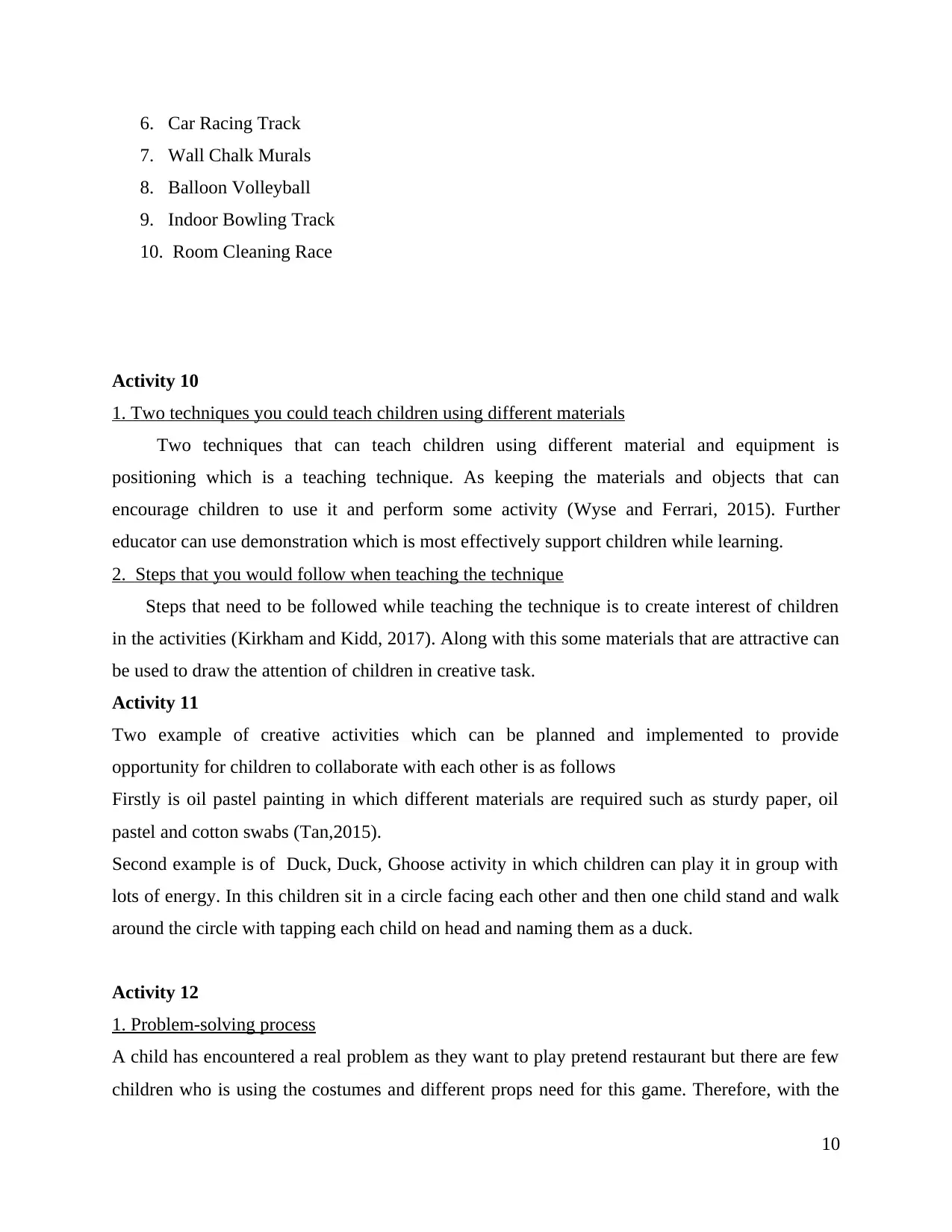
6. Car Racing Track
7. Wall Chalk Murals
8. Balloon Volleyball
9. Indoor Bowling Track
10. Room Cleaning Race
Activity 10
1. Two techniques you could teach children using different materials
Two techniques that can teach children using different material and equipment is
positioning which is a teaching technique. As keeping the materials and objects that can
encourage children to use it and perform some activity (Wyse and Ferrari, 2015). Further
educator can use demonstration which is most effectively support children while learning.
2. Steps that you would follow when teaching the technique
Steps that need to be followed while teaching the technique is to create interest of children
in the activities (Kirkham and Kidd, 2017). Along with this some materials that are attractive can
be used to draw the attention of children in creative task.
Activity 11
Two example of creative activities which can be planned and implemented to provide
opportunity for children to collaborate with each other is as follows
Firstly is oil pastel painting in which different materials are required such as sturdy paper, oil
pastel and cotton swabs (Tan,2015).
Second example is of Duck, Duck, Ghoose activity in which children can play it in group with
lots of energy. In this children sit in a circle facing each other and then one child stand and walk
around the circle with tapping each child on head and naming them as a duck.
Activity 12
1. Problem-solving process
A child has encountered a real problem as they want to play pretend restaurant but there are few
children who is using the costumes and different props need for this game. Therefore, with the
10
7. Wall Chalk Murals
8. Balloon Volleyball
9. Indoor Bowling Track
10. Room Cleaning Race
Activity 10
1. Two techniques you could teach children using different materials
Two techniques that can teach children using different material and equipment is
positioning which is a teaching technique. As keeping the materials and objects that can
encourage children to use it and perform some activity (Wyse and Ferrari, 2015). Further
educator can use demonstration which is most effectively support children while learning.
2. Steps that you would follow when teaching the technique
Steps that need to be followed while teaching the technique is to create interest of children
in the activities (Kirkham and Kidd, 2017). Along with this some materials that are attractive can
be used to draw the attention of children in creative task.
Activity 11
Two example of creative activities which can be planned and implemented to provide
opportunity for children to collaborate with each other is as follows
Firstly is oil pastel painting in which different materials are required such as sturdy paper, oil
pastel and cotton swabs (Tan,2015).
Second example is of Duck, Duck, Ghoose activity in which children can play it in group with
lots of energy. In this children sit in a circle facing each other and then one child stand and walk
around the circle with tapping each child on head and naming them as a duck.
Activity 12
1. Problem-solving process
A child has encountered a real problem as they want to play pretend restaurant but there are few
children who is using the costumes and different props need for this game. Therefore, with the
10
Paraphrase This Document
Need a fresh take? Get an instant paraphrase of this document with our AI Paraphraser
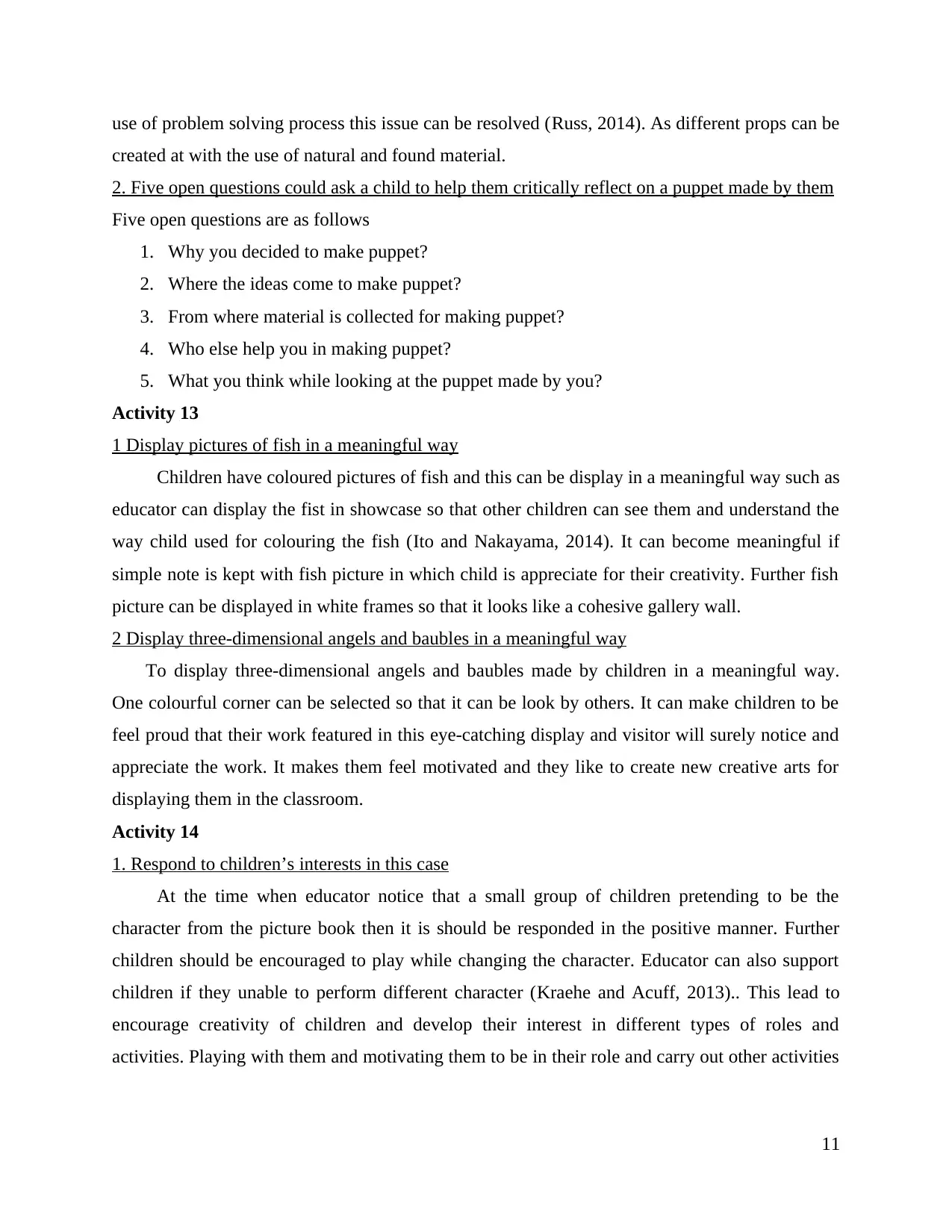
use of problem solving process this issue can be resolved (Russ, 2014). As different props can be
created at with the use of natural and found material.
2. Five open questions could ask a child to help them critically reflect on a puppet made by them
Five open questions are as follows
1. Why you decided to make puppet?
2. Where the ideas come to make puppet?
3. From where material is collected for making puppet?
4. Who else help you in making puppet?
5. What you think while looking at the puppet made by you?
Activity 13
1 Display pictures of fish in a meaningful way
Children have coloured pictures of fish and this can be display in a meaningful way such as
educator can display the fist in showcase so that other children can see them and understand the
way child used for colouring the fish (Ito and Nakayama, 2014). It can become meaningful if
simple note is kept with fish picture in which child is appreciate for their creativity. Further fish
picture can be displayed in white frames so that it looks like a cohesive gallery wall.
2 Display three-dimensional angels and baubles in a meaningful way
To display three-dimensional angels and baubles made by children in a meaningful way.
One colourful corner can be selected so that it can be look by others. It can make children to be
feel proud that their work featured in this eye-catching display and visitor will surely notice and
appreciate the work. It makes them feel motivated and they like to create new creative arts for
displaying them in the classroom.
Activity 14
1. Respond to children’s interests in this case
At the time when educator notice that a small group of children pretending to be the
character from the picture book then it is should be responded in the positive manner. Further
children should be encouraged to play while changing the character. Educator can also support
children if they unable to perform different character (Kraehe and Acuff, 2013).. This lead to
encourage creativity of children and develop their interest in different types of roles and
activities. Playing with them and motivating them to be in their role and carry out other activities
11
created at with the use of natural and found material.
2. Five open questions could ask a child to help them critically reflect on a puppet made by them
Five open questions are as follows
1. Why you decided to make puppet?
2. Where the ideas come to make puppet?
3. From where material is collected for making puppet?
4. Who else help you in making puppet?
5. What you think while looking at the puppet made by you?
Activity 13
1 Display pictures of fish in a meaningful way
Children have coloured pictures of fish and this can be display in a meaningful way such as
educator can display the fist in showcase so that other children can see them and understand the
way child used for colouring the fish (Ito and Nakayama, 2014). It can become meaningful if
simple note is kept with fish picture in which child is appreciate for their creativity. Further fish
picture can be displayed in white frames so that it looks like a cohesive gallery wall.
2 Display three-dimensional angels and baubles in a meaningful way
To display three-dimensional angels and baubles made by children in a meaningful way.
One colourful corner can be selected so that it can be look by others. It can make children to be
feel proud that their work featured in this eye-catching display and visitor will surely notice and
appreciate the work. It makes them feel motivated and they like to create new creative arts for
displaying them in the classroom.
Activity 14
1. Respond to children’s interests in this case
At the time when educator notice that a small group of children pretending to be the
character from the picture book then it is should be responded in the positive manner. Further
children should be encouraged to play while changing the character. Educator can also support
children if they unable to perform different character (Kraehe and Acuff, 2013).. This lead to
encourage creativity of children and develop their interest in different types of roles and
activities. Playing with them and motivating them to be in their role and carry out other activities
11
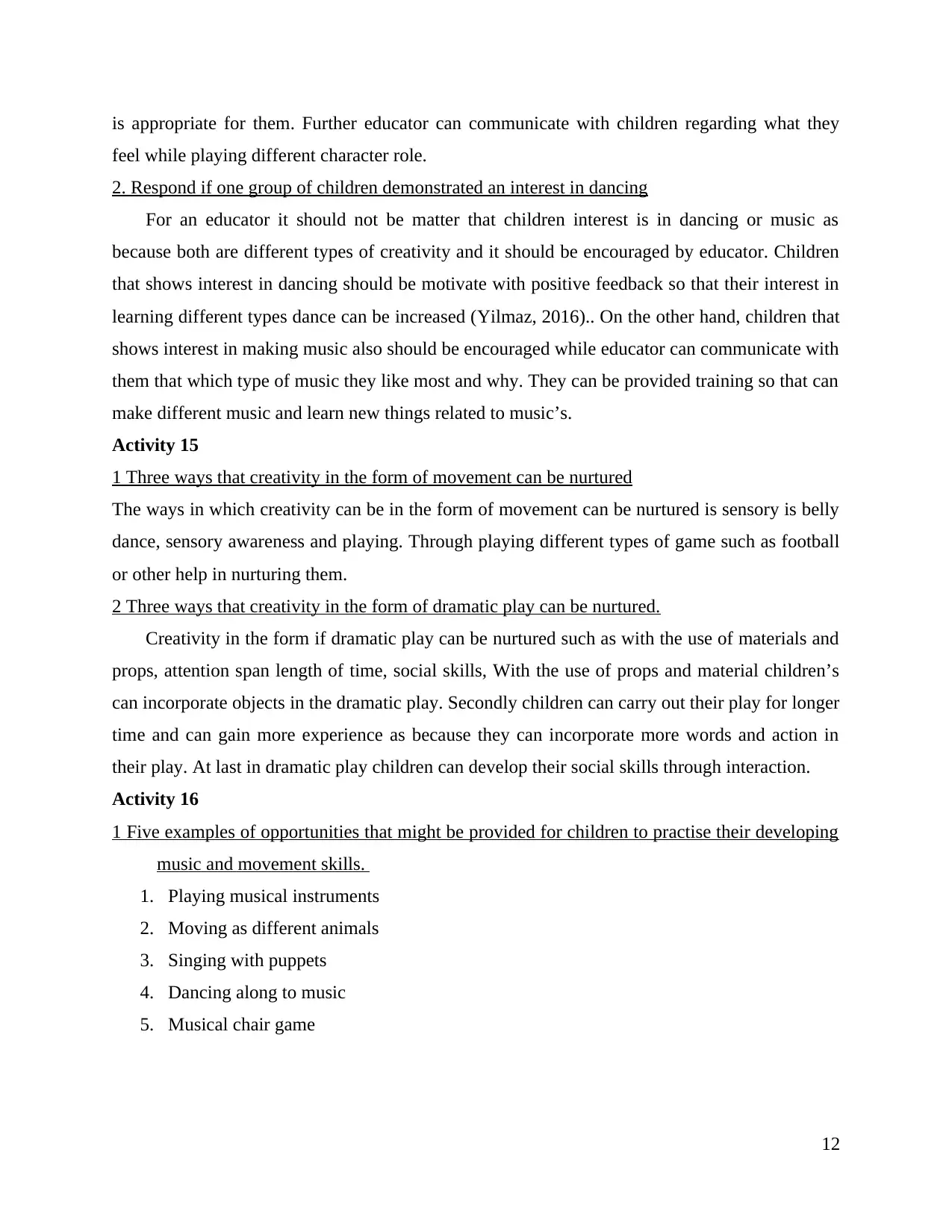
is appropriate for them. Further educator can communicate with children regarding what they
feel while playing different character role.
2. Respond if one group of children demonstrated an interest in dancing
For an educator it should not be matter that children interest is in dancing or music as
because both are different types of creativity and it should be encouraged by educator. Children
that shows interest in dancing should be motivate with positive feedback so that their interest in
learning different types dance can be increased (Yilmaz, 2016).. On the other hand, children that
shows interest in making music also should be encouraged while educator can communicate with
them that which type of music they like most and why. They can be provided training so that can
make different music and learn new things related to music’s.
Activity 15
1 Three ways that creativity in the form of movement can be nurtured
The ways in which creativity can be in the form of movement can be nurtured is sensory is belly
dance, sensory awareness and playing. Through playing different types of game such as football
or other help in nurturing them.
2 Three ways that creativity in the form of dramatic play can be nurtured.
Creativity in the form if dramatic play can be nurtured such as with the use of materials and
props, attention span length of time, social skills, With the use of props and material children’s
can incorporate objects in the dramatic play. Secondly children can carry out their play for longer
time and can gain more experience as because they can incorporate more words and action in
their play. At last in dramatic play children can develop their social skills through interaction.
Activity 16
1 Five examples of opportunities that might be provided for children to practise their developing
music and movement skills.
1. Playing musical instruments
2. Moving as different animals
3. Singing with puppets
4. Dancing along to music
5. Musical chair game
12
feel while playing different character role.
2. Respond if one group of children demonstrated an interest in dancing
For an educator it should not be matter that children interest is in dancing or music as
because both are different types of creativity and it should be encouraged by educator. Children
that shows interest in dancing should be motivate with positive feedback so that their interest in
learning different types dance can be increased (Yilmaz, 2016).. On the other hand, children that
shows interest in making music also should be encouraged while educator can communicate with
them that which type of music they like most and why. They can be provided training so that can
make different music and learn new things related to music’s.
Activity 15
1 Three ways that creativity in the form of movement can be nurtured
The ways in which creativity can be in the form of movement can be nurtured is sensory is belly
dance, sensory awareness and playing. Through playing different types of game such as football
or other help in nurturing them.
2 Three ways that creativity in the form of dramatic play can be nurtured.
Creativity in the form if dramatic play can be nurtured such as with the use of materials and
props, attention span length of time, social skills, With the use of props and material children’s
can incorporate objects in the dramatic play. Secondly children can carry out their play for longer
time and can gain more experience as because they can incorporate more words and action in
their play. At last in dramatic play children can develop their social skills through interaction.
Activity 16
1 Five examples of opportunities that might be provided for children to practise their developing
music and movement skills.
1. Playing musical instruments
2. Moving as different animals
3. Singing with puppets
4. Dancing along to music
5. Musical chair game
12
⊘ This is a preview!⊘
Do you want full access?
Subscribe today to unlock all pages.

Trusted by 1+ million students worldwide
1 out of 25
Related Documents
Your All-in-One AI-Powered Toolkit for Academic Success.
+13062052269
info@desklib.com
Available 24*7 on WhatsApp / Email
![[object Object]](/_next/static/media/star-bottom.7253800d.svg)
Unlock your academic potential
Copyright © 2020–2025 A2Z Services. All Rights Reserved. Developed and managed by ZUCOL.




